[1]
R. Mahmudi, and M. Eslami: Journal Materials Science: Material Electron, Vol. 22 (2011), pp.1168-1172.
Google Scholar
[2]
A. Kantarcıoğlu, and Y. E. Kalay: Materials Science & Engineering, Vol. 593 (2014), pp.79-84.
Google Scholar
[3]
M. Sadiq, J. S. Lecomte, and M. Cherkaoui: Chaotic Modeling and Simulation (CMSIM), Vol. 2 (2013), pp.335-348.
Google Scholar
[4]
J. W. Evans, in: A Guide to Lead-free Solders: Physical Metallurgy and Reliability, 1st Edition, Springer-Verlag, London (2006).
Google Scholar
[5]
M. A. A. M. Salleh, M. A. Abdullah, F. Somidin, A. V. Sandu, N. Saud, K. Hussin, S. D. McDonald, and K. Nogita: Revista de Chimie (Bucharest), Vol. 64 (2013), pp.725-727.
Google Scholar
[6]
Y. F. Yan, J. H. Zhu, F. X. Chen, J. G. He, and D. X. Yang: Trans. Nonferrous Met. Soc. China, Vol. 16 (2006), pp.1116-1200.
Google Scholar
[7]
M. A. A. M. Salleh, M.M.A. Abdullah, H. Kamarudin, M. Bnhussain, M.H. Zan, and S. Flora: Physics Procedia, Vol. 22 (2011), pp.299-304.
Google Scholar
[8]
T. Siewert, S. Liu, D. R. Smith, and J. C. Madeni, in: Database for Solder Properties with Emphasis on New Lead-free Solders: Properties of lead-free solders, 4th Edition, Colorado School of Mines, U.S. A (2002).
DOI: 10.1109/ectc.2001.928000
Google Scholar
[9]
J. M. Eric, in: Fundamentals of Materials Science: The Microstructure-Property Relationship Using Metals as Model Systems, 1st Edition, University of Stuttgart Heisenbergstr, Germany (2010).
Google Scholar
[10]
A. A. El-Daly, F. El-Tantawyb, A. E. Hammada, M.S. Gaafar, E.H. El-Mossalamy, and A.A. Al-Gamdi, Journal of Alloys and Compounds, Vol. 509 (2011), p.7238–7246.
DOI: 10.1016/j.jallcom.2011.01.062
Google Scholar
[11]
A.R. Nurul Razliana, A. Nisrin, N. Saud, and S.A. Musa: Advanced Materials Engineering and Technology III, Vol. 754-755 (2015), pp.166-170.
Google Scholar
[12]
J.F. Guo, J. Liu, C.N. Sun, S. Maleksaeedi, G. Bi, M.J. Tan, and J. Wei: Materials Science & Engineering, Vol. 602 (2014), pp.143-149.
Google Scholar
[13]
L.C. Tsao, S.Y. Chang, C.I. Lee, W.H. Sun, and C.H. Huang: Materials and Design, Vol. 31 (2010), pp.4831-4835.
Google Scholar
[14]
K.J. Puttlitz and K. A Stalter: Handbook of Lead-Free Solder Technology for Microelectronic Assemblies (Marcel Dekker, Inc., New York 2004).
DOI: 10.1201/9780203021484
Google Scholar
[15]
X.L. Zhong, and M. Gupta: Journal of Physics D : Applied Physics, Vol. 41 (2008), pp.1-7.
Google Scholar
[16]
T. Fouzder, A.K. Gain, Y.C. Chan, A. Sharif, and W.K.C. Yung: Microelectronics Reliability, Vol. 50 (2010), p.2051-(2058).
Google Scholar
[17]
A.K. Gain, Y.C. Chan, and W.K.C. Yung: Microelectronics Reliability, Vol. 51 (2011), pp.975-984.
Google Scholar


